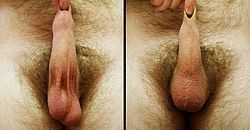- Scrotum
-
Scrotum 
Human scrotum (both tense and relaxed states) Gray's subject #258 1237 Artery Anterior scrotal artery & Posterior scrotal artery Vein Testicular vein Nerve Posterior scrotal nerves, Anterior scrotal nerves, genital branch of genitofemoral nerve, perineal branches of posterior femoral cutaneous nerve Lymph Superficial inguinal lymph nodes Precursor labioscrotal folds MeSH Scrotum In some male mammals the scrotum is a dual-chambered protuberance of skin and muscle containing the testicles and divided by a septum.[1] It is an extension of the perineum, and is located between the penis and anus. In humans and some other mammals, the base of the scrotum becomes covered with curly pubic hairs at puberty. The scrotum is homologous to the labia majora in females.
Contents
Function
The function of the scrotum appears to be to keep the temperature of the testes slightly lower than that of the rest of the body.[2] For human beings, the temperature should be one or two degrees Celsius below body temperature (around 37 degrees Celsius or 99 degrees Fahrenheit); higher temperatures may be damaging to sperm count. The temperature is controlled by the scrotum moving the testicles closer to the abdomen when the ambient temperature is cold, and further away when it is hot. Moving the testes away from the abdomen and increasing the exposed surface area allow a faster dispersion of excess heat. This is done by means of contraction and relaxation of the cremaster muscle in the abdomen and the dartos fascia (muscular tissue under the skin) in the scrotum
However, this may not be the main function of the scrotum. The volume of sperm produced by the testes is small (0.1-0.2 ml).[clarification needed] It has been suggested that if testes were situated within the abdominal cavity that they would be subjected to the regular changes in abdominal pressure that is exerted by the abdominal muscles. This squeezing and relaxing would result in the more rapid emptying of the testes and epididymis of sperm before the spermatozoa were matured sufficiently for fertilization. Some mammals—elephants and marine mammals, for example—do keep their testes within the abdomen and there may be mechanisms to prevent this inadvertent emptying.
Contraction of the abdominal muscles, and changes in intra-abdominal pressure, often can lift and lower the testicles within the scrotum. Contraction of the muscle fibers of the dartos tunic (or fascia) is completely involuntary and results in the appearance of increased wrinkling and thickening of the scrotal skin. The testicles are not directly attached to the skin of the scrotum, so this dartos contraction results in their sliding toward the abdomen. They also, in some men, can be lifted the same way by tightening the anus and pelvic muscles, doing Kegel exercises.
 Diagram of the scrotum. On the left side the cavity of the tunica vaginalis has been opened; on the right side only the layers superficial to the Cremaster muscle have been removed.
Diagram of the scrotum. On the left side the cavity of the tunica vaginalis has been opened; on the right side only the layers superficial to the Cremaster muscle have been removed.
Although the ideal temperature for sperm growth varies between species, it usually appears, in warm-blooded species, to be a bit cooler than internal body temperature, necessitating the scrotum. Since this leaves the testicles vulnerable in many species, there is some debate on the evolutionary advantage of such a system. One theory is that the impregnation of females who are ill is less likely when sperm is highly sensitive to elevated body temperatures. An alternative explanation is to protect the testes from jolts and compressions associated with an active lifestyle. Animals that have stately movements—such as elephants, whales, and marsupial moles—have internal testes and no scrotum.[3]
Innervation
Nerve Surface[4] genital branch of genitofemoral nerve anterolateral Anterior scrotal nerves (from ilioinguinal nerve) anterior Posterior scrotal nerves (from perineal nerve) posterior perineal branches of posterior femoral cutaneous nerve inferior Health issues
A study has indicated that use of a laptop computer positioned on the lap can affect sperm production negatively.[5] A common problem of the scrotum is the development of masses. Common scrotal masses include
- Sebaceous cyst, also called an epidermal cyst
- hydrocele
- hematocele
- spermatocele
- varicocele
Other conditions include:
- Blisters: Caused by chafing or scratching of the scrotum while the scrotum is damp. Often seen in males undergoing puberty, as emerging pubic hairs cause the urge to itch. Powdering the scrotum to absorb moisture can help to prevent this issue.
- contact dermatitis: may cause redness, burning, swelling, and itching of the entire scrotum. Can result from soaps, solvents, detergents, and natural irritants such as poison ivy.
- inguinal hernia
- yeast infection
- swelling resulting from conditions external to the scrotum, including:
- heart failure
- kidney or liver disease
- Cherry angioma
- testicular torsion
- cello scrotum, which was revealed in 2009 to be a hoax
References
- ^ "Scrotum". National Institutes of Health. http://www.nlm.nih.gov/medlineplus/ency/article/002296.htm. Retrieved 6 January 2011.
- ^ "About the Male Reproductive System". KidsHealth. http://kidshealth.org/parent/general/body_basics/male_reproductive.html#a_About_the_Male_Reproductive_System. Retrieved 6 January 2011.
- ^ "Science : Bumpy lifestyle led to external testes - 17 August 1996 - New Scientist". http://www.newscientist.com/article/mg15120432.000-science--bumpy-lifestyle-led-to-external-testes.html. Retrieved 2007-11-06.
- ^ Moore, Keith; Anne Agur (2007). Essential Clinical Anatomy, Third Edition. Lippincott Williams & Wilkins. p. 132. ISBN 0-7817-6274-X.
- ^ Laptops may damage male fertility
Additional images
Categories:- Male reproductive system
Wikimedia Foundation. 2010.



